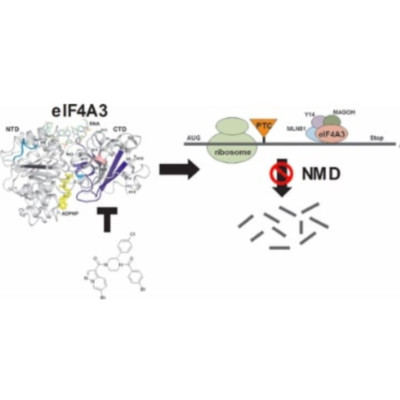Abstract
Eukaryotic initiation factor 4A-3 (eIF4A3) is an Asp-Glu-Ala-Asp (DEAD) box-family adenosine triphosphate (ATP)-dependent RNA helicase. Subtypes eIF4A1 and eIF4A2 are required for translation initiation, but eIF4A3 participates in the exon junction complex (EJC) and functions in RNA metabolism including nonsense-mediated RNA decay (NMD). No small molecules for NMD inhibition via selective inhibition of eIF4A3 have been discovered. Here, we identified allosteric eIF4A3 inhibitors from a high-throughput screening campaign. Chemical optimization of the lead compounds based on ATPase activity yielded compound 2, which exhibited noncompetitive inhibition with ATP or RNA and high selectivity for eIF4A3 over other helicases. The optimized compounds suppressed the helicase activity of eIF4A3 in an ATPase-dependent manner. Hydrogen/deuterium exchange mass spectrometry demonstrated that the deuterium-incorporation pattern of compound 2 overlapped with that of an allosteric pan-eIF4A inhibitor, hippuristanol, suggesting that compound 2 binds to an allosteric region on eIF4A3. We examined NMD activity using a luciferase-based cellular reporter system and a quantitative real-time polymerase chain-reaction-based cellular system to monitor levels of endogenous NMD substrates. NMD suppression by the compounds correlated positively with their ATPase-inhibitory activity. In conclusion, we developed a novel eIF4A3 inhibitor that targets the EJC. The optimized chemical probes represent useful tools for understanding the functions of eIF4A3 in RNA homeostasis.
